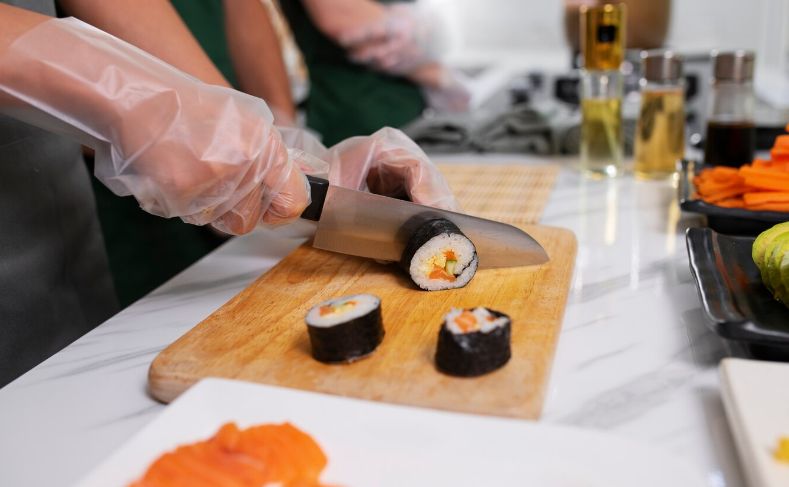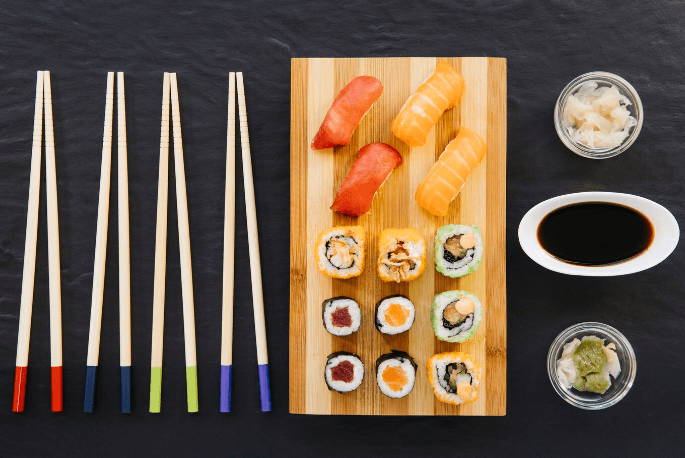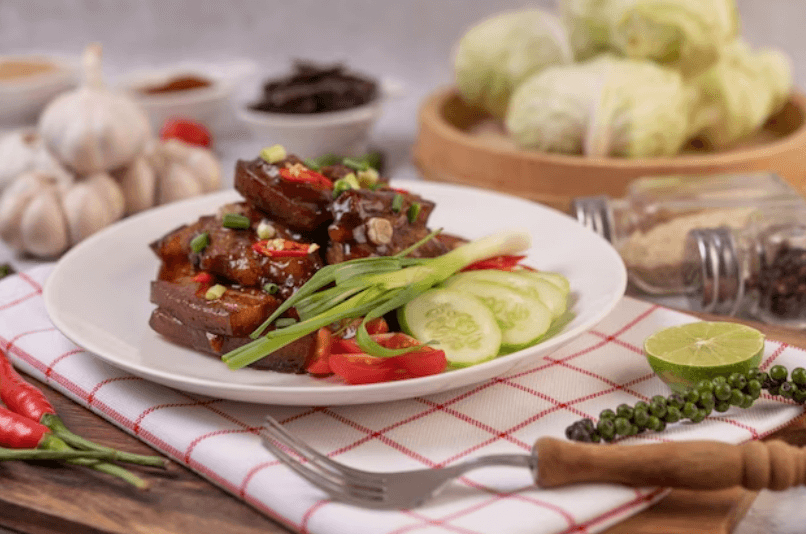Learn How to Cut Sushi Like a Pro

Are you a sushi enthusiast who wants to elevate your sushi game? Knowing the art of sushi preparation is essential, and one crucial skill to master is how to cut sushi with precision and finesse. Whether you’re a home cook or aspire to be a professional sushi chef, our step-by-step guide will teach you all the culinary tips and tricks to help you become a pro at cutting sushi.
Cutting sushi may seem like a simple task, but it requires specific techniques to ensure that your sushi looks and tastes incredible. The way you slice the fish and shape the rice can make a significant difference in the overall presentation and flavors of your sushi rolls. With our detailed instructions and expert advice, you’ll be able to create beautifully-cut sushi that is not only visually appealing but also consistently delicious.
With our step-by-step guide, you’ll learn everything from choosing the right knife and sharpening it to make clean cuts, to understanding the different types of sushi rolls and how to cut each one correctly. We’ll also share insider tips on slicing sashimi and nigiri, as well as expert techniques for creating decorative cuts and garnishes that will impress your guests.
Whether you’re a sushi novice or an experienced home cook, our step-by-step guide will take you through the process of cutting sushi like a pro. So, get ready to hone your sushi skills and unlock the secrets to mastering this timeless culinary art form. Let’s dive in and explore the world of sushi preparation together!
Gather the Necessary Tools and Ingredients
When it comes to sushi preparation, having the right tools and ingredients is essential. With the following items in your kitchen, you’ll be able to create sushi like a pro:
Sushi Knife
A high-quality sushi knife is crucial for achieving clean and precise cuts. Look for a knife with a long, narrow blade and a sharp edge. This will allow you to slice through the sushi rolls effortlessly.
Bamboo Mat
A bamboo mat, also known as a sushi mat or sushi roller, is used to roll and shape the sushi. It provides stability and helps you achieve the perfect cylindrical shape. Make sure to have one on hand before you start.
Ingredients
Of course, sushi wouldn’t exist without the right ingredients. Here are some common ones you’ll need:
- Sushi Rice: This short-grain rice is sticky and holds the sushi together.
- Nori: The seaweed wrap that goes around the rice and ingredients.
- Fillings: You can choose from a variety of fillings such as fresh fish, vegetables, and seafood.
- Condiments: Soy sauce, wasabi, and pickled ginger are traditional condiments that complement sushi flavors.
Make sure to have these ingredients readily available before you start your sushi-making adventure.
Prepare the Rice and Fillings
Gather the Ingredients
To make sushi, you will need sushi rice, nori (seaweed sheets), and a variety of fillings such as raw fish, vegetables, or tofu. Make sure you have all the necessary ingredients before you begin.
Cook the Rice
The key to making good sushi is having perfectly cooked rice. Rinse the sushi rice well to remove excess starch, then cook it according to the package instructions. Remember to use the proper ratio of rice to water for a fluffy and sticky texture.
Prepare the Fillings
While the rice is cooking, you can start preparing the fillings. Cut the raw fish or vegetables into thin, uniform slices. You can also marinate the fish in soy sauce or other seasonings for added flavor.
Pro tip: If you’re using raw fish, make sure it is fresh and of high quality. Only use sushi-grade fish for raw preparations.
Cool and Season the Rice
Once the rice is cooked, transfer it to a large bowl. Use a wooden spatula to gently mix in sushi vinegar, which is a mixture of rice vinegar, sugar, and salt. Be careful not to overmix or mash the rice, as it can affect the texture.
Set Up Your Workstation
Before you start cutting sushi, make sure you have a clean and organized workstation. Have a sharp knife, a bamboo sushi mat, and a bowl of water nearby for dipping your hands or knife.
Now that you have prepared the rice and fillings, you’re ready to move on to the next step: assembling and cutting sushi like a pro.
Choose the Right Fish and Other Seafood
When it comes to cutting sushi like a pro, choosing the right fish and seafood is crucial. The quality and freshness of the ingredients will greatly affect the taste and texture of your sushi. Here are some tips to help you make the best choices for your sushi preparation:
1. Freshness is Key
For the best sushi experience, always prioritize freshness. Look for fish that has firm flesh and bright, clear eyes. Fresh fish should not have any unpleasant odors. When purchasing seafood, make sure it is stored properly and kept at a consistent temperature to ensure freshness.
2. Consider Texture and Flavor
Choose fish and seafood with textures and flavors that complement each other and the other ingredients in your sushi. Some popular choices for sushi include tuna, salmon, yellowtail, and shrimp. Each of these options has its own unique taste and texture, offering a variety of choices to suit different preferences.
Remember to consider the preferences of your guests if you’re serving sushi to a group. Offering a selection of fish and seafood options can accommodate different tastes and dietary restrictions.
By choosing the right fish and other seafood, you’ll be able to create sushi rolls that are both visually appealing and delicious. Experiment with different combinations and don’t be afraid to try new flavors! Happy sushi preparation!
Master the Art of Sushi Rolling
Prepare Your Ingredients
Before you start rolling sushi, it’s important to have your ingredients prepared and ready. Make sure you have fresh fish, vegetables, and sushi rice available. Slice the fish into thin strips, julienne the vegetables, and season the sushi rice with vinegar.
Assemble Your Sushi Roll
Place a bamboo sushi mat on a clean surface and cover it with a sheet of plastic wrap. Lay a sheet of nori seaweed on top of the plastic wrap. Wet your hands with water to prevent the rice from sticking. Take a handful of sushi rice and spread it evenly over the nori, leaving a small border at the top.
Now it’s time to add your filling. Place the fish or vegetables in a line across the rice, about an inch from the bottom of the nori. Using the bamboo mat, carefully roll the sushi, applying gentle pressure to shape it into a tight cylinder. Use the bamboo mat to help you roll the sushi away from you, tucking in the filling as you go.
Once your sushi is rolled, use a sharp knife to cut it into bite-sized pieces. Wet the knife with water between cuts to ensure clean slices.
Master Different Sushi Rolls
There are various types of sushi rolls you can master, such as maki rolls, nigiri rolls, and inside-out rolls. Each type requires different techniques and ingredients, so don’t be afraid to experiment and try new combinations.
| Sushi Roll Type | Ingredients | Technique |
|---|---|---|
| Maki Roll | Nori, sushi rice, fish or vegetables | Rolling the sushi using a bamboo mat |
| Nigiri Roll | Sushi rice, fish or other toppings | Shaping the sushi rice by hand and topping it with ingredients |
| Inside-Out Roll | Nori, sushi rice, fish or vegetables, sesame seeds | Rolling the sushi with the rice on the outside |
Remember, practice makes perfect when it comes to sushi rolling. Don’t be discouraged if your first rolls don’t turn out perfectly. With time and experience, you’ll be able to create beautiful and delicious sushi rolls like a pro.
Learn the Different Types of Sushi Rolls
When it comes to sushi, there are countless varieties and types of rolls to choose from. Each roll is carefully crafted with unique combinations of ingredients and flavors, making it a delicious and diverse dish. Whether you’re a sushi enthusiast or just starting to explore the world of sushi, it’s essential to familiarize yourself with the different types of sushi rolls. By doing so, you’ll be able to appreciate the artistry that goes into creating each roll and develop a deeper understanding of this popular Japanese cuisine.
Here are some of the most common types of sushi rolls:
| Sushi Roll | Description |
|---|---|
| Nigiri | A simple and classic sushi roll consisting of a slice of raw fish or seafood placed on top of a small mound of vinegared rice. |
| Maki | A type of sushi roll that typically involves a sheet of seaweed (nori) wrapped around a filling of rice, vegetables, and sometimes raw or cooked fish. |
| Temaki | Also known as a hand roll, this type of sushi roll is made by hand-rolling a sheet of seaweed (nori) around a variety of fillings. |
| Uramaki | A sushi roll that features the rice on the outside, with a sheet of seaweed (nori) wrapped around the filling. |
| Futomaki | A thicker sushi roll that contains multiple ingredients, including vegetables, fish, and other seafood. |
| Chirashi | A type of sushi roll that consists of a bowl of sushi rice topped with various sashimi (sliced raw fish or seafood) and garnishes. |
By learning about the different types of sushi rolls, you’ll be able to choose the ones that suit your taste preferences and expand your culinary horizons. Whether you prefer the simplicity of nigiri or the complexity of uramaki, each type of sushi roll offers a unique and flavorful experience. So, the next time you’re at a sushi restaurant or trying your hand at making sushi at home, be sure to explore these different types of sushi rolls and discover the ones that make your taste buds sing!
Discover the Secrets of Perfect Sushi Cutting
Mastering the art of sushi preparation is one thing, but cutting the sushi is a whole other skill. The way you cut sushi can greatly affect its taste, texture, and appearance. To help you become a sushi cutting pro, we’ve compiled some culinary tips that will take your sushi game to the next level.
1. Choose the Right Knife
When it comes to cutting sushi, having the right knife is essential. A sharp and high-quality sushi knife, known as a “yanagiba,” is traditionally used for precision slicing. The long and thin blade allows for clean and precise cuts, ensuring that the sushi maintains its shape and texture. Make sure to keep your sushi knife well-maintained and sharpened for optimal results.
2. Master the Technique
Proper technique is key to achieving perfect sushi cuts. Begin by holding the sushi firmly but gently with your non-dominant hand. Use the sushi knife to slice through the roll in one smooth motion, applying slight pressure. Avoid using a sawing motion, as this can squish the sushi and ruin its appearance. Aim for clean and even slices, around 1/2 to 3/4 inch thick.
Pro tip: Wetting the blade of your sushi knife with a damp cloth before each cut can help prevent sticking and ensure smoother slices.
Now that you’ve unlocked the secrets of perfect sushi cutting, you’re ready to impress your guests with beautifully presented sushi. Remember to practice and hone your skills, as sushi cutting is an art that takes time and patience to master. Happy sushi cutting!
Understand the Importance of Knife Sharpening
Cutting sushi like a pro requires more than just a steady hand and a sharp knife. One of the most essential culinary tips for sushi preparation is to ensure that your knife is properly sharpened. Here’s why knife sharpening is crucial when it comes to creating perfect slices of sushi:
- Precision: A properly sharpened knife allows you to achieve precise cuts, ensuring that each slice of seafood, vegetable, or rice is consistent in size and shape. This precision is crucial in sushi making, as it contributes to the overall aesthetics and presentation of the dish.
- Efficiency: Sharp knives require less force to cut through ingredients, which means you can work more efficiently in the kitchen. When it comes to sushi preparation, time is of the essence, and a sharp knife will help you streamline the process and achieve smoother, cleaner cuts.
- Taste: Believe it or not, the sharpness of your knife can affect the taste of the sushi. When a knife is dull, it can crush delicate ingredients instead of cleanly slicing through them. This can result in a loss of flavor and texture in the final dish. A sharp knife ensures that the integrity of the ingredients is preserved, enhancing the overall taste experience.
- Safety: A dull knife is more likely to slip and cause accidents in the kitchen. By keeping your knife properly sharpened, you reduce the risk of injury, making the sushi preparation process safer and more enjoyable.
Now that you understand the importance of knife sharpening in sushi making, it’s time to learn how to sharpen your knives like a pro. Stay tuned for our step-by-step guide on knife sharpening techniques!
Follow the Correct Slicing Techniques
When it comes to sushi preparation, proper slicing techniques are essential. Mastering these techniques will not only make your sushi look professional, but it will also enhance the flavors and textures in each bite. Here are some culinary tips to help you cut sushi like a pro:
1. Use a sharp knife: A sharp knife is crucial for clean and precise cuts. Dull knives can crush the sushi and make it look messy.
2. Wet your knife: Before starting to cut, wet your knife with a damp towel or dip it in water. This will prevent the rice from sticking to the blade and ensure smooth, clean cuts.
3. Use gentle pressure: Apply gentle pressure when cutting through the sushi roll. Pressing too hard can result in squished or deformed sushi pieces.
4. Cut in one swift motion: Make sure to slice the sushi roll in one swift motion without sawing back and forth. This will help maintain the integrity of the roll and prevent the ingredients from being pushed out.
5. Sharpen your skills: Practice makes perfect, so don’t be discouraged if your first attempts are not flawless. Keep practicing your cutting skills and soon you’ll be able to cut sushi like a true pro!
By following these slicing techniques, you’ll be able to elevate the presentation of your sushi and make it even more enjoyable to eat. So grab your knife, practice these tips, and impress your friends and family with beautifully sliced sushi!
Experiment with Different Sushi Presentation Styles
Here are a few different sushi presentation styles you can experiment with:
Traditional Style:
The traditional style of sushi presentation focuses on simplicity and elegance. Arrange your sushi pieces neatly on a traditional sushi tray or a wooden platter. Use minimal garnish, such as daikon radish or shiso leaf, to highlight the natural colors and shapes of the sushi. This style is perfect for showcasing the freshness and quality of the ingredients.
Creative Style:
If you’re feeling adventurous, try exploring your creative side with sushi presentation. Use unique serving dishes and plates that complement the sushi’s colors and textures. Experiment with different garnishes and sauces to add visual interest and enhance the flavors. This style allows you to showcase your personality and culinary skills.
Remember, presentation is not just about the aesthetics – it’s also about functionality. Consider how the sushi will be eaten and make sure it’s easy to pick up with chopsticks or fingers. Avoid making the pieces too large or stacked too high, as it can make them difficult to eat.
By experimenting with different sushi presentation styles, you can elevate your sushi-making skills and create an unforgettable dining experience for yourself and your guests. So go ahead, get creative, and have fun with your sushi presentation!
Explore the World of Sushi Sauces and Condiments
When it comes to sushi preparation, one of the most important aspects is the selection of sauces and condiments. These flavorful additions can greatly enhance the taste and overall experience of eating sushi. In this article, we will explore some of the popular sushi sauces and condiments that you can use to take your sushi to the next level.
1. Soy Sauce
Soy sauce is an essential condiment that is commonly used in sushi. It adds a savory and umami flavor to the sushi, enhancing the taste of the fish and rice. When using soy sauce, it’s important to dip the sushi fish-side down to prevent the rice from falling apart. You can also mix wasabi in soy sauce to create a spicy dipping sauce.
2. Wasabi
Wasabi is a green paste made from Japanese horseradish. It has a strong and spicy flavor that can clear your sinuses in an instant. Wasabi is usually served as a condiment alongside sushi. You can apply a small amount of wasabi directly onto the sushi or mix it with soy sauce to create a spicy dipping sauce. Be careful though, as wasabi can be quite potent!
Aside from soy sauce and wasabi, there are also other sushi sauces and condiments that you can experiment with:
3. Ponzu Sauce:
Ponzu sauce is a citrus-based sauce made from a combination of soy sauce, lemon or lime juice, and vinegar. It has a tangy and refreshing taste that complements sushi, especially seafood rolls. Ponzu sauce can be drizzled on top of sushi or used as a dipping sauce.
4. Eel Sauce:
Eel sauce, also known as unagi sauce, is a thick and sweet glaze that is commonly used in sushi. It is made from a mixture of soy sauce, mirin, and sugar, which is then reduced until it becomes sticky and syrupy. Eel sauce is typically used in dishes that feature eel, such as unagi nigiri or eel rolls.
Whether you’re a sushi connoisseur or just starting out on your sushi journey, experimenting with different sauces and condiments can be a fun and delicious experience. From the classic soy sauce and wasabi combination to more adventurous options like ponzu sauce and eel sauce, there are endless possibilities to elevate your sushi experience. So go ahead and get creative with your sushi preparations!
Learn About Sushi Etiquette and Traditional Practices
When it comes to enjoying sushi, it’s not just about how to cut sushi like a pro. There is a whole world of sushi etiquette and traditional practices that every sushi lover should be aware of. Understanding and respecting these customs can enhance your dining experience and show a deeper appreciation for this beloved Japanese cuisine.
One of the most important aspects of sushi etiquette is the use of chopsticks. When picking up a piece of sushi, use one hand to hold the chopsticks and the other hand to support the sushi. It’s considered impolite to rub your chopsticks together, as this implies that they are cheap or low-quality.
Another important rule is to dip your sushi fish-side down into soy sauce. This helps to preserve the delicate balance of flavors, ensuring that the fish remains the star of the dish. Be careful not to over dip, as it can overpower the taste of the sushi.
Traditional sushi etiquette also dictates that you should eat sushi in one bite whenever possible. Taking small, dainty bites is not only considered impolite, but it also disrupts the proper balance of flavors that the sushi chef has carefully crafted.
When dining at a sushi restaurant, it’s polite to greet the chef and express your appreciation for their culinary skills. This gesture shows respect and creates a welcoming atmosphere. It’s also customary to wait for everyone at the table to be served before starting to eat. This promotes a sense of togetherness and allows for a shared culinary experience.
Learning about sushi etiquette and traditional practices can greatly enhance your enjoyment of this exquisite cuisine. By following these culinary tips, you not only show respect for the culture, but you also gain a deeper understanding of the artistry and craftsmanship behind each piece of sushi.
Get Inspired by Famous Sushi Chefs and Their Techniques
If you want to take your sushi preparation to the next level and learn how to cut sushi like a pro, there’s no better way to get inspired than by observing the techniques of famous sushi chefs. These culinary masters have dedicated their lives to perfecting the art of sushi and have developed unique and innovative ways of creating sushi masterpieces.
By studying the techniques of these famous sushi chefs, you can learn valuable culinary tips and tricks that will enhance your sushi-making skills. From precise knife movements to expertly slicing the fish, these chefs have mastered the art of sushi and can teach you how to elevate your own creations.
One such chef is Jiro Ono, the owner of Sukiyabashi Jiro in Tokyo. His legendary sushi restaurant has been awarded three Michelin stars and is widely regarded as one of the best sushi establishments in the world. Jiro Ono’s technique is characterized by his intense focus and attention to detail, ensuring that every piece of sushi is cut and presented with precision.
Another famous sushi chef is Nobu Matsuhisa, the creator of the Nobu empire. His fusion style of sushi combines traditional Japanese techniques with South American flavors, resulting in unique and delicious sushi creations. Nobu’s technique focuses on balancing flavors and textures, creating sushi that is both visually stunning and delectable.
By observing these famous sushi chefs and studying their techniques, you can gain valuable insights into the art of sushi making. Pay attention to their knife handling, their attention to detail, and their overall approach to sushi preparation. By incorporating these techniques into your own sushi-making process, you can improve your skills and create sushi like a pro.
So, if you’re looking to take your sushi-making skills to the next level, don’t hesitate to get inspired by famous sushi chefs and their techniques. Watch videos, read books, and practice their methods. With dedication and practice, you’ll be cutting sushi like a pro in no time.
Practice, Practice, Practice – Become a Sushi Cutting Expert
Learning how to cut sushi like a pro requires dedication and practice. While the art of sushi preparation may seem daunting at first, with enough practice, you can become a sushi cutting expert.
One of the key elements to perfecting your sushi cutting skills is repetition. The more you practice, the more comfortable you will become with handling the knife and slicing the fish. Start by practicing basic cuts, such as slicing sashimi or cutting maki rolls. As you become more confident, you can move on to more advanced techniques, such as creating beautiful nigiri sushi.
When practicing your sushi cutting skills, it’s important to focus on precision and consistency. Aim to make clean and even cuts, ensuring that each piece of sushi is of the same size. This will not only enhance the aesthetics of your sushi but also improve the overall dining experience for your guests.
In addition to practicing your cutting techniques, it’s also essential to familiarize yourself with the different types of sushi knives and their uses. Each knife has a specific purpose and is designed to achieve specific cuts. By understanding which knife to use for each task, you’ll be able to maximize your efficiency and produce professional-looking sushi.
| Knife Type | Description |
|---|---|
| Yanagiba | A long, thin knife used for slicing sashimi |
| Deba | A heavy, thick knife used for cutting fish and removing bones |
| Usuba | A thin, rectangular blade knife used for precision cuts and vegetable preparation |
| Gyuto | A versatile chef’s knife used for various cutting tasks, including slicing fish for sushi |
Remember, practice makes perfect. The more you practice your sushi cutting skills, the better you will become. Don’t be discouraged if your first attempts don’t turn out perfectly. Keep practicing, experimenting, and refining your techniques, and soon you’ll be cutting sushi like a pro.
Question-Answer:
What are the essential tools for cutting sushi?
The essential tools for cutting sushi are a sharp, non-serrated knife, a bamboo sushi mat, and a damp towel.
What is the best type of knife for cutting sushi?
The best type of knife for cutting sushi is a single bevel Japanese knife, such as a Yanagiba or a Deba knife. These knives are specially designed for slicing raw fish and have a sharp edge that cuts through the sushi rolls cleanly.
What is the proper technique for cutting sushi rolls?
The proper technique for cutting sushi rolls is to hold the knife with a loose grip and use a gentle sawing motion to slice through the roll. It’s important to use a sharp knife and apply even pressure to get clean and neat slices.
How can I prevent the rice from sticking to the knife when cutting sushi?
To prevent the rice from sticking to the knife when cutting sushi, you can wet the knife blade with water or vinegar before making each slice. This will help create a clean cut and prevent the rice from sticking to the knife.





